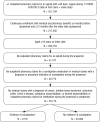Comparing Healthcare Utilization and Costs Among Medicaid-Insured Patients with Chronic Noncancer Pain with and without Opioid-Induced Constipation: A Retrospective Analysis
- PMID: 28626504
- PMCID: PMC5470245
Comparing Healthcare Utilization and Costs Among Medicaid-Insured Patients with Chronic Noncancer Pain with and without Opioid-Induced Constipation: A Retrospective Analysis
Abstract
Background: Constipation is a common adverse effect of opioid use and has been associated with increased healthcare utilization and costs among patients receiving opioids for pain management.
Objective: To compare the healthcare utilization and costs of Medicaid patients with chronic noncancer pain with and without constipation who were receiving opioids.
Methods: This retrospective, claims-based study was conducted using data from the Truven Health MarketScan Medicaid Multi-State database. Patients with no evidence of cancer who initiated opioid therapy between January 1, 2009, and June 30, 2013, were eligible for the study. Patients had to have continuous enrollment in the database in the 6 months before and 12 months after opioid initiation, with no evidence of substance abuse or functional or inflammatory bowel disease. Medical and pharmacy claims during the 12 months after opioid initiation were evaluated for a diagnosis of constipation or for prescription or over-the-counter medications indicative of constipation. All-cause healthcare utilization and costs were measured over the same period and were compared between propensity score-matched cohorts of patients with evidence of constipation and patients without constipation.
Results: Of the 25,744 patients meeting the study inclusion criteria, 2716 (10.5%) had evidence of constipation. After 1:1 propensity score matching, the 2 cohorts had similar demographic and clinical characteristics (ie, mean age, 47 years; 26%-27% male). During the 12-month follow-up period, healthcare utilization was more frequent among patients with constipation, including inpatient admissions and emergency department visits, than in the matched patients without constipation. The total all-cause mean healthcare costs were substantially higher among the patients with constipation ($28,234; 95% confidence interval [CI], $24,307-$32,160) than in the patients without constipation ($13,709; 95% CI, $12,618-$14,801), with a median cost difference of $4166 per patient (P <.001).
Conclusion: Among Medicaid enrollees who receive opioids for chronic noncancer pain, constipation is associated with increased all-cause healthcare utilization and costs.
Keywords: Medicaid; chronic pain; constipation; costs; healthcare utilization; noncancer pain; opioid-induced constipation; opioids; propensity score matching; side effects.
Similar articles
-
Increased Burden of Healthcare Utilization and Cost Associated with Opioid-Related Constipation Among Patients with Noncancer Pain.Am Health Drug Benefits. 2016 May;9(3):160-70. Am Health Drug Benefits. 2016. PMID: 27606040 Free PMC article.
-
Economic burden of opioid-induced constipation among long-term opioid users with noncancer pain.Am Health Drug Benefits. 2015 Apr;8(2):93-102. Am Health Drug Benefits. 2015. PMID: 26005516 Free PMC article.
-
Impact of opioid-induced constipation on healthcare resource utilization and costs for cancer pain patients receiving continuous opioid therapy.Support Care Cancer. 2019 Feb;27(2):687-696. doi: 10.1007/s00520-018-4366-z. Epub 2018 Jul 29. Support Care Cancer. 2019. PMID: 30056531
-
Healthcare Resource Use and Costs Associated with Opioid Initiation Among Patients with Newly Diagnosed Endometriosis with Commercial Insurance in the USA.Adv Ther. 2020 Jun;37(6):2777-2791. doi: 10.1007/s12325-020-01361-7. Epub 2020 May 12. Adv Ther. 2020. PMID: 32399813 Free PMC article.
-
Health care resource use and cost differences by opioid therapy type among chronic noncancer pain patients.J Pain Res. 2017 Jul 21;10:1713-1722. doi: 10.2147/JPR.S130913. eCollection 2017. J Pain Res. 2017. PMID: 28769587 Free PMC article.
Cited by
-
Opioid-Induced Constipation: Cost Impact of Approved Medications in the Emergency Department.Adv Ther. 2022 May;39(5):2178-2191. doi: 10.1007/s12325-022-02090-9. Epub 2022 Mar 17. Adv Ther. 2022. PMID: 35298784 Free PMC article.
-
Cumulative Laxation Response with Methylnaltrexone: Implications for Hospitalized Patients with Advanced Illness and Opioid-Induced Constipation.Curr Ther Res Clin Exp. 2023 Jan 29;98:100694. doi: 10.1016/j.curtheres.2023.100694. eCollection 2023. Curr Ther Res Clin Exp. 2023. PMID: 36875317 Free PMC article.
-
American Gastroenterological Association Institute Technical Review on the Medical Management of Opioid-Induced Constipation.Gastroenterology. 2019 Jan;156(1):229-253.e5. doi: 10.1053/j.gastro.2018.08.018. Epub 2018 Oct 16. Gastroenterology. 2019. PMID: 30337104 Free PMC article. Review. No abstract available.
References
-
- Johannes CB, Le TK, Zhou X, et al. The prevalence of chronic pain in United States adults: results of an Internet-based survey. J Pain. 2010; 11: 1230–1239. - PubMed
-
- Turk DC, Wilson HD, Cahana A. Treatment of chronic non-cancer pain. Lancet. 2011; 377: 2226–2235. - PubMed
-
- Clark JD. Chronic pain prevalence and analgesic prescribing in a general medical population. J Pain Symptom Manage. 2002; 23: 131–137. - PubMed
LinkOut - more resources
Full Text Sources


